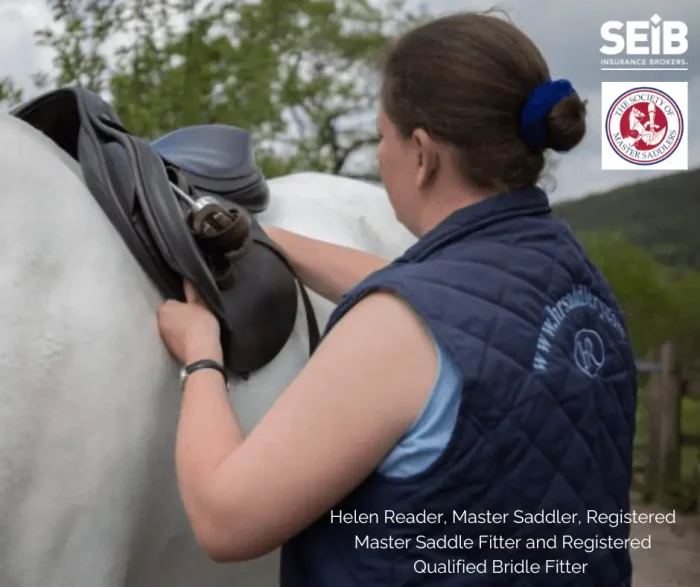We all want our horses to be happy and comfortable when they are being ridden. There are many factors that can help our horses enjoy their ridden work. Making sure the saddle is correctly put on is important for your horse’s welfare.
Our Horse Insurance team caught up with the Society of Master Saddlers, Master Saddler and Registered Master Saddle Fitter and Registered Qualified Bridle Fitter, Helen Reader to find out more about the things we need to do to ensure we are putting the saddle on correctly.
Helen has run her company, HR Saddlery since 2004 and has been qualified and working as a saddle fitter for 25 years. In addition to this she is regularly out competing and is also a Master Harness Maker and a Master Bridle Maker.

Where should a saddle sit on a horse?
The saddle needs to sit behind the shoulder. If the saddle is too far forward and on the horse’s shoulder, it will block the free movement of the shoulder. The end of the tree of the saddle should finish before the last thoracic vertebrae. This can be assessed by finding the last rib and following the natural curve up to where it meets the saddle. The end of the tree is roughly where the skirt finishes. The panel of the saddle can go slightly beyond the last thoracic vertebrae, as when a horse works and lifts through its frame this area of the back extends and will support the panel.
What sort of saddle pad should I use to make sure my horse is comfortable when being ridden?
In an ideal world a saddle pad or numnah isn’t necessary. Numnahs were introduced many years ago simply to help keep the saddle clean. A thin cotton numnah can be used to keep the saddle clean, this will not affect the fit of the saddle. There should always be a reason for using a pad on a horse. It may be because the horse has a sensitive back, or if he is a thoroughbred, he may be thin skinned and a pad may help. If you are planning to use a thicker saddle pad or gel pad it is important to discuss this with your qualified saddle fitter as if the saddle has been fitted to the horse, then the addition of a thick pad will change the fit of the saddle and this could lead to problems. If your qualified saddle fitter knows a pad is required then they can fit the saddle with this in mind.
My saddle has a selection of girth straps, which ones should I use?
Traditionally, a saddle had three girth straps and the advice would generally be to use the first and last straps. Modern saddles now often have up to 5 girth straps. They are there to give fitting options and your qualified saddle fitter will be able to assess which you should use. I generally suggest using the first and third strap and then assess what happens, making further adjustments as required. Factors such as the saddle slipping forward and where the horse’s girth groove sits can result in using different straps. It is all about what best suits the horse and the overall stability of the saddle.
What type of girth should I use to ensure my horse’s comfort?
I often suggest using a broad girth. The greater surface area results in spreading the pressure. However, conformation plays a part, sometimes a broad girth can pinch behind the elbows so we assess each horse individually to find what works best – often through trial and error. Also, softer girths are generally better, but they still need a firm core to stop them from curling at the edges, which could cause pinching. There is an immense choice of girths on the market, from the material used through to the shape of the girth.
To find out more information on ensuring your horse’s saddle and bridle fit correctly please see our previous blog post with Helen, How to measure a horse saddle.
For more information on the services offered by Helen Reader at HR Saddlery please visit www.hrsaddlery.com.
To find your local qualified saddle or bridle fitter and for the full list of The Society of Master Saddlers qualified members please visit www.mastersaddlers.co.uk.
About SEIB
SEIB have been arranging insurance for horses for over 60 years. As part of our Horse Insurance policies, we can arrange tack and saddlery insurance to help you protect your equipment.